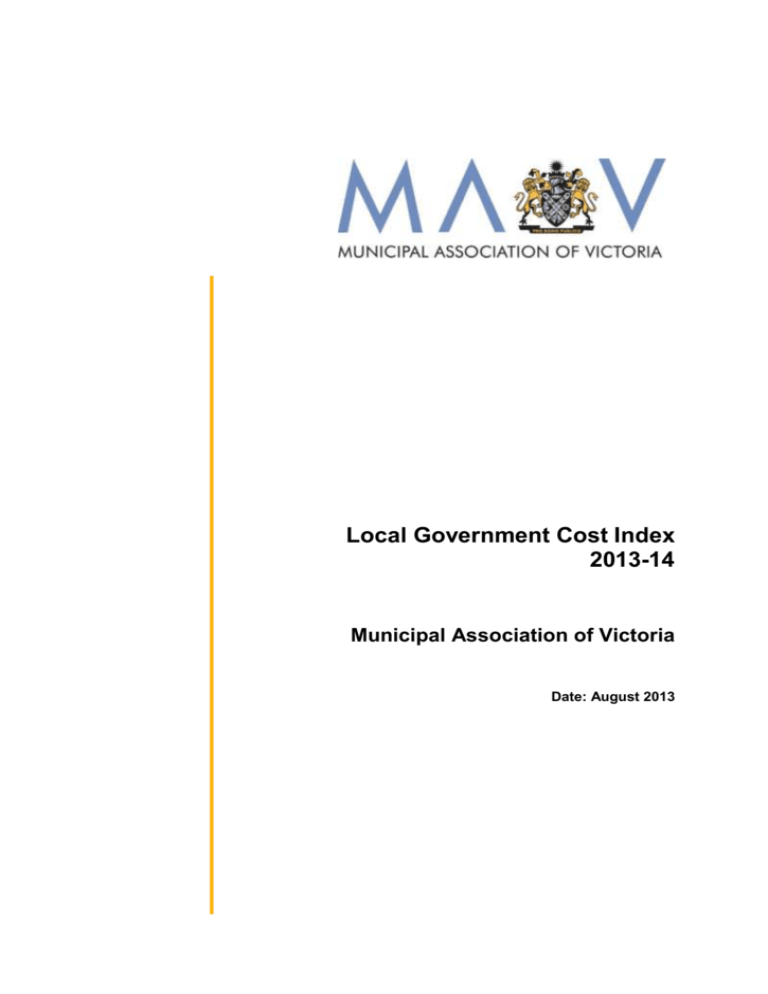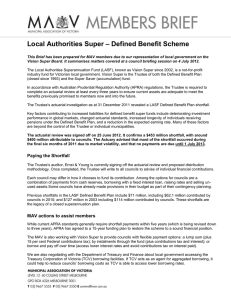2013 cost index report (Word
advertisement

Local Government Cost Index 2013-14 Municipal Association of Victoria Date: August 2013 6 © Copyright Municipal Association of Victoria, 2013. The Municipal Association of Victoria is the owner of the copyright in the publication Local Government Cost Index 2013-14 No part of this publication may be reproduced, stored or transmitted in any form or by any means without the prior permission in writing from the Municipal Association of Victoria. All requests to reproduce, store or transmit material contained in the publication should be addressed to Owen Harvey-Beavis on 9667 5584. The MAV can provide this publication in an alternative format upon request, including large print, Braille and audio. Table of Contents 1 Introduction ............................................................................................................... 3 2 Future of the Cost Index ........................................................................................... 3 3 Limitations of the index ............................................................................................. 4 4 Local Government Cost Index ................................................................................... 4 4.1 Methodology .......................................................................................................... 4 4.2 Carbon price .......................................................................................................... 5 5 Results...................................................................................................................... 5 6 References ............................................................................................................... 6 2 Local Government Cost Index 2013-14 1 Introduction This report calculates the Local Government Cost Index (LGCI) for 2013-14. The index is calculated in line with the MAV’s established methodology, which adopts publicly available forecast movement in wage and construction costs as the basis for estimating the future increase in councils’ input costs. The analysis estimates the LGCI for 2013-14 will be 3.4 per cent. This means that for councils to deliver the same services (in both quantity and quality) as it did in 201213, it will increase its costs by the LGCI or 3.4 per cent. Changes in services quantity or services are not incorporated in the index. 2 Future of the Cost Index This report is based on the existing methodology and approach that the MAV has used since the LGCI’s introduction in 2007. Earlier this year, the Victorian Auditor-General’s Office (2013) completed a review of councils’ rating strategies and recommended that the Victorian Government work with the MAV to: …review the adequacy of the Local Government Cost Index and encourage the use of an agreed benchmark by councils in the annual reporting of their rates and charges The MAV believes that the critique of the Index is limited. First, a criticism has been made that the index uses economy wide movements in input costs to wages and construction, rather than the sector’s actual shifts in input costs. However, this criticism does not indicate why their cost structures should be inherently higher than economy wide movements. A second criticism is that the Index invariably falls short of councils’ rate increases. This criticism misses the fundamental point of the index: to estimate the movement in cost of providing councils’ services. Population growth, service level changes and additional functions should not be reported on in this context, since they reflect substantive changes in the quality and quantity of services. In addition, with grants being indexed below councils’ true cost input changes, rate increases will invariably be higher than the local government cost index. This can hardly be considered a limitation of the index, since the effect of inadequate grants will depend on an individual council’s reliance on various revenue sources. When incorporating the above into councils’ future financial and rating strategies, it is clear that incorporating all of those features would require a different estimate of future cost growth for each council. In short, while the MAV will review the cost index before 2014-15 in line with the Auditor General’s recommendation, the Association believes that it is valuable to provide an estimate for the 2013-14 year utilising the existing methodology. 3 Local Government Cost Index 2013-14 3 Limitations of the index The LGCI attempts to estimate the increased input costs facing councils in 2013-14 to deliver services at the same level and quality as they did in 2012-13. Several factors can influence a councils’ need to increase costs at a level greater than the LGCI: Service growth, typically through increasing population Increased scope of services, such as new services provided to the community Increased quality of services delivered to the community In addition, many of councils’ revenue sources are escalated at a rate below underlying growth in costs, which means that rates need to increase at a level above movements in overall expenditure. As such, the index does not attempt to measure the actual movements in councils’ costs. It is however an analytic tool to better asses and understand the sector’s expenditure patterns over time. 4 Local Government Cost Index 4.1 Methodology Analysis completed by the MAV (2011) has indicated that approximately 20 per cent of expenses are in the form of construction and other capital, with a vast majority of the remaining expenditure in the form of employee wages and materials and contracts. On the basis of this division of expenditure and a strong correlation between economy-wide movements in wages and councils’ non-construction costs, the MAV has calculated the LGCI based on 80 per cent employee costs and 20 per cent construction costs. Both these measures are based on forecasts of cost increases over the 2013-14 year and are hence sensitive to changed economic conditions. Wages in the sector have historically been closer to movements in Average Weekly Earnings (AWE) than the Wage Price Index (WPI). The former measures the average wages within the economy and therefore incorporates shifts in labour force composition and skill levels. The latter measures movements in wages for specific occupations. The extent to which the composition of councils’ labour force shifts in line with the broader economy, AWE will be a better indicator of the sector’s wage cost movements. However, if the sector does not have significant compositional shifts, or if its skill set does not match the broader economy, then WPI may be a better comparator for the sector. 4 Local Government Cost Index 2013-14 4.2 Carbon price The 2012-13 Local Government Cost Index made an allowance of 0.57 percentage points for the influence of the carbon price on landfills and energy consumption (electricity and gas). Additional cost escalation associated with construction was already incorporated in the construction price index and no separate provisions were made for any influence of the carbon price on construction. The consumer price index for year to June 2013 was 2.4 per cent. Treasury modelling indicated that the carbon price was expected to contribute 0.7 percentage points to inflation in the 2012-13 year. The final effect of the carbon price was not able to be measured by ABS, although the benign inflationary figures in 2012-13 suggests that actual experience was unlikely to exceed the Treasury forecasts. No specific analysis has been undertaken by the MAV to estimate whether its earlier prediction of 0.57 percentage points (excluding construction) was accurate. As such, the LGCI has retained a one-off additional carbon price escalator of 0.57 percentage points for the 2012-13 year. 5 Results The LGCI for 2013-14 is forecast to be 3.4 per cent, driven primarily by wage prices increasing at 3.5 per cent. The Index for 2012-13 has been revised upwards to 4.4 per cent (in 2012 this figure was forecast as 3.9 per cent), primarily as a consequence of significant increases in the engineering construction price index. Table 1: Local Government Cost Index 2011-12 to 2014-15 2011-12a Construction costs Engineering construction price index Non-residential construction price index Average construction price index Wage price index Commonwealth Budget estimate State Budget estimate Average Allowance for carbon price LGCI 2012-13b 2013-14b 2014-15b 3.82% 1.9% 2.8% 11.04% -1.1% 5.0% 3.00% 2.9% 3.0% 2.95% 3.0% 3.0% 3.70% 3.50% 3.60% 0.00% 3.45% 3.50% 3.50% 3.50% 0.57% 4.36% 3.50% 3.50% 3.50% 0.00% 3.39% 3.50% 3.50% 3.50% 0.00% 3.39% Notes: a Actual data. b Forecast data Source: Australian Construction Forecasts, engineering and non-residential construction price index (2013); Australian Government Budget 2013-14; Victorian Government Budget 2013-14. 5 Local Government Cost Index 2013-14 6 References Municipal Association of Victoria (2011), Local Government Cost Index 2011-12 Victorian Auditor General’s Office (2013) Rating Practices in Local Government, February 2013, Victorian Government Printer. 6 Local Government Cost Index 2013-14











